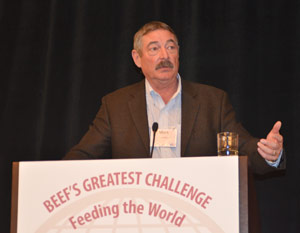ILC–USA 2012
Knowing Your Global Customers and Competition
by Kasey Miller, API associate editor
DENVER (Jan. 10, 2012) — Nearly 95% of beef is consumed outside of the United States, Mark Gustafson, JBS International Sales, told attendees of the 2012 International Livestock Congress (ILC) in Denver, Colo.
To establish markets, he said, you have to know the customer and know the market. Who is producing beef? Who is consuming beef? And who can pay for beef?

Mark Gustafson photos by Kasey Miller
Per capita consumption is always higher in beef-producing countries, which also tend to be countries with higher gross domestic product (GDP), including the United States, Australia, Canada, Brazil and Mexico. Countries with lower GDP and lower beef consumption are opportunities for imports, he added.
There are many requirements in international trade, including various forms of macro trade environment, country-specific requirements, market requirements, customer requirements, the supply chain, cut specifications and packaging.
Gustafson outlined some of the U.S. beef industry's strengths, weakenesses, opportunities and threats, offering suggestions as to how the industry could best match its strengths to market needs. Among its greatest strengths, he listed cost effective, grain-fed taste and marbling, consistent product and supply, USDA grading and scale.
Gustafson suggested the industry use all of the regulatory oversight beef has to meet as a merchandising tool. The meat industry, he said, “is the second most regulated industry after nuclear engineering.”
Some of the biggest threats to the U.S. beef industry, Gustafson said, are lack of traceability, lingering concerns over bovine spongiform encephalopathy (BSE), its political image, slow to change to meet customer demand, and hefty import duties.
Traceability is a large issue, he said. Consumers say they want traceability, but they don’t know in what context. Many countries can’t define traceability or to whom they want to trace the animals to — the processing plant, the feedlot, the stocker or the cow-calf operation.
“The driver for traceability should be animal health, not for exports,” he said.
Understanding the competition
Gustafson shared insights on several of the United States' strongest competitors in the beef market.
Australia has no market restrictions. It has a strong traceability policy, is disease-free, can market all ages of cattle, and doesn’t use beta-agonists (growth promotants). It has both grain- and grass-fed cattle, though most cattle are grass-fed. It is an export-focused industry, so it has developed strong marketing techniques. Cattlemen there do have high grain-fed production costs.
South America has traceability systems in place, but it does have a disease challenge with foot-and-mouth disease (FMD). South America markets all ages of beef, and cattle are mostly grass-fed. It does not use beta-agonists. By selling mostly boxed beef by the cut and lean meats, it is competitive in price.
Canada, said Gustafson, is a love/hate relationship in that it is a competitor and a trade partner. The Canadians do have a traceability system, though still in the relatively early stages. They do have a disease challenge with BSE. They must market calves fewer than 30 months and sell boxed beef by the cut. Their cattle are mostly grain-fed, and they do use beta-agonists.
Gustafson said that from a competitive standpoint, the biggest challenges for U.S. beef exports are lack of a traceability system; beta-agonist use for Taiwan, China and Russia; hormone use for the European Union; and antibiotic residue limit differences among countries.
He mentioned that USDA policies are based on the domestic market, not on the export market, which puts the United States at a disadvantage with trade of other countries.
“We need to figure out how to entertain the export market,” he said.
On a positive note, he said, the low value of the U.S. dollar has been helpful. Exchange rates are in our favor and, because of it, have helped increase our exports by 27%.
For additional coverage of ILC–2012, return to the ILC index page.
Editor’s Note: The above article was written under contract or by staff of Angus Productions Inc. (API). It may not be reprinted without express permission of API. To request reprint permision, contact the editor at 816-383-5200.
This section of the API Virtual Library contains event coverage provided by the editorial team at Angus Productions Inc. (API), publisher of the Angus Journal, the Angus Beef Bulletin, the Angus Beef Bulletin EXTRA and the Angus e-List. For questions about this site, to submit an article for our consideration, or to report a broken link, contact the editor at 816-383-5200; 3201 Frederick Ave., Saint Joseph, MO 64506.
API claims copyright to this website as presented. We welcome educational venues and cattlemen to link to this site as a service to their audience.






